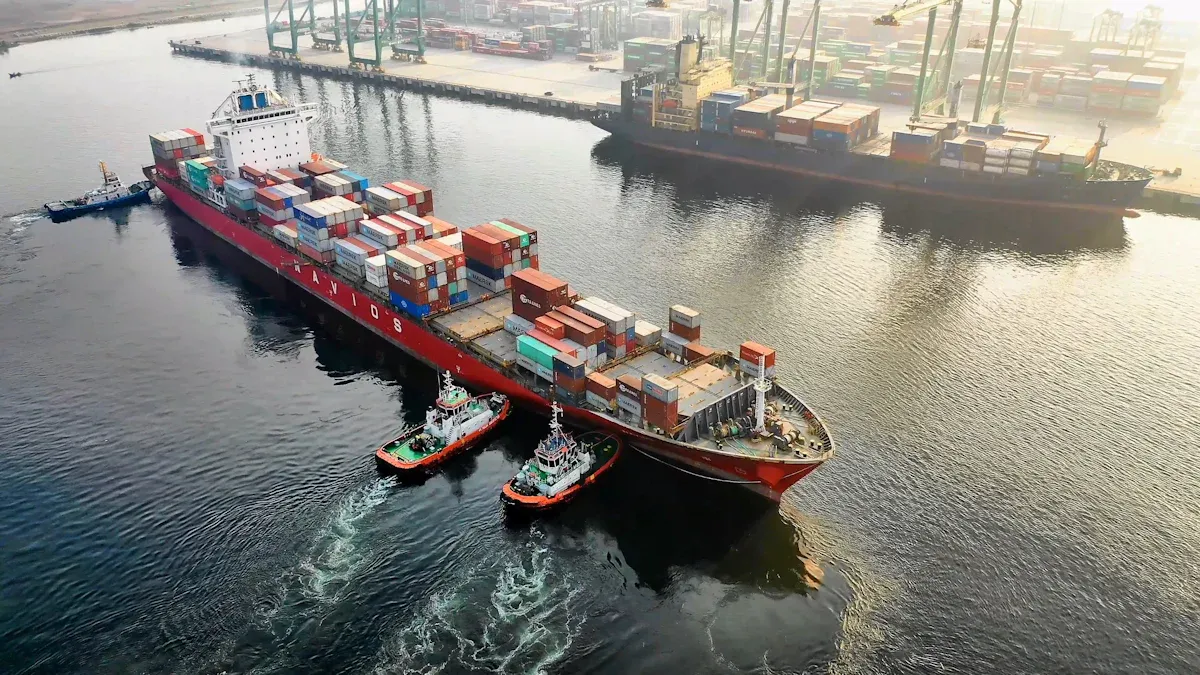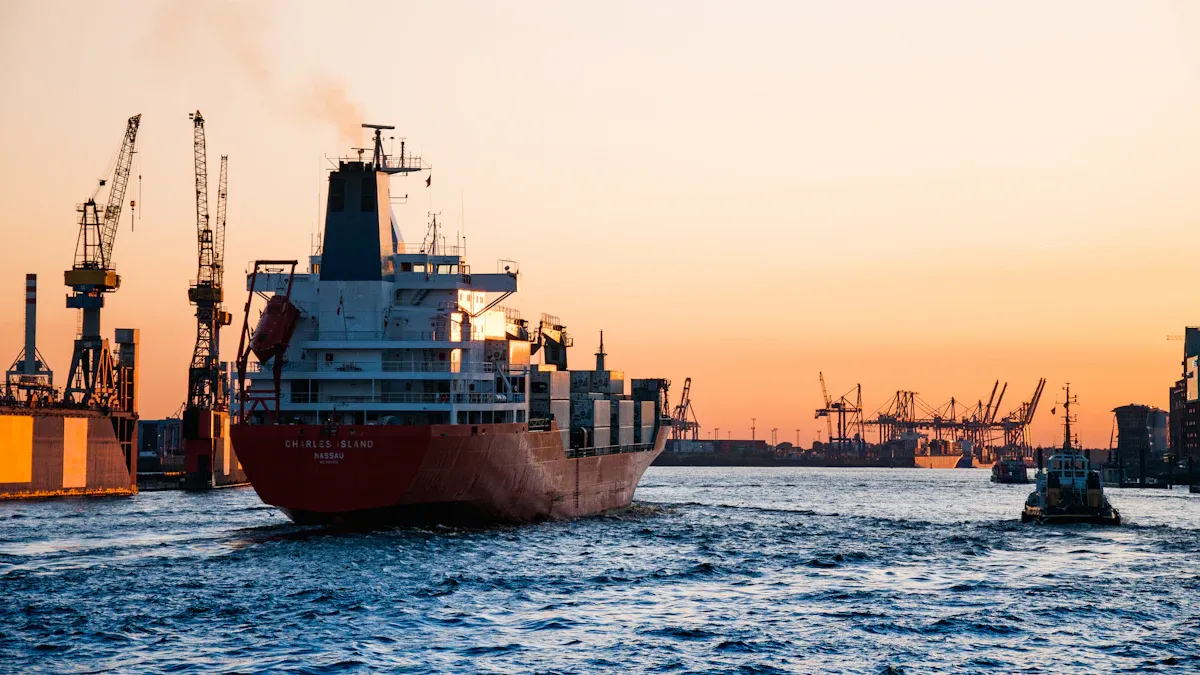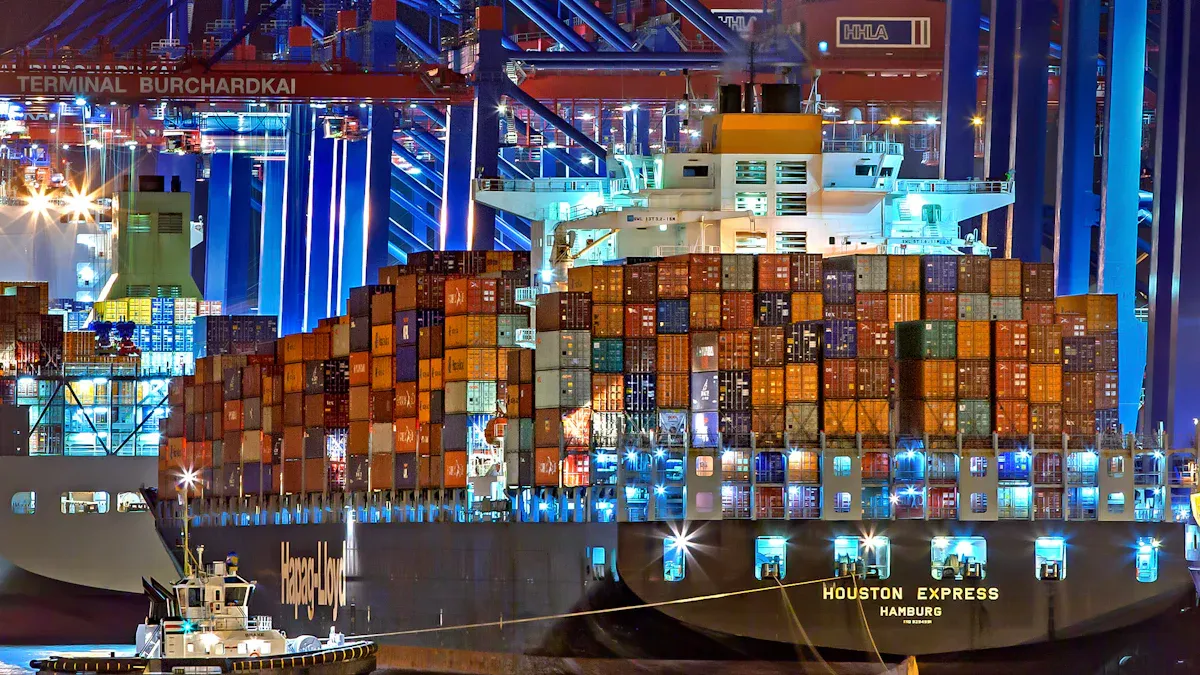Emerging Trends in International Logistics and Freight Costs for 2025

Shipping and delivery costs are crucial for global trade, especially when considering overseas logistics prices. For instance, Drewry’s World Container Index may exceed $4,000 per 40-foot container in 2024. Shipping prices could rise by 20% annually. Businesses must adapt swiftly to these fluctuations. Research indicates that companies investing over $750,000 a year on shipping recognize the necessity to stay updated with new trends.
Key Takeaways
Shipping prices will likely go up a lot in 2025. Companies need to watch trends and change their shipping plans.
Tools like AI and robots can make shipping faster. Businesses should use these tools to save money and avoid mistakes.
Using different suppliers can lower risks from problems. Companies should have many sources to keep supplies steady and prices fair.
Current Challenges in International Logistics
Supply chain disruptions and their impact on overseas logistics prices
Supply chain problems are a big issue in shipping. Wars like Russia-Ukraine and Hamas-Israel caused delays and higher costs. For example, attacks on ships during these wars made shipping prices rise a lot.
Event | Impact on Supply Chain Problems | Effect on Shipping Costs |
|---|---|---|
Big problems from ship attacks | Huge increases in costs | |
Russia-Ukraine War | Changed global supply chains | Higher shipping prices |
These problems spread through the shipping market, raising costs. Tariffs and shipping fees go up during such events. Delivery delays happen more often, making businesses change their plans.
Geopolitical factors influencing global logistics trends
World politics strongly affect shipping trends. Trade fights, sanctions, and alliances bring new tariffs and rules. These changes make shipping more expensive and harder to manage. For example, tariffs on goods can raise shipping costs.
Shipping routes may change, and some ports may close. These issues cause delays and higher shipping prices. Knowing about world events helps you prepare and adjust for smoother shipping.
Shipping container shortage and capacity constraints
There is still a shortage of shipping containers. COVID-19 made this worse, with shipping times going from 60 to over 100 days. Shipping costs have almost doubled, with moving a 40-foot container from China now very expensive.
Shipping prices dropped 53% from April to July 2022, falling from $15,764 to $7,400 for a 40-foot container. This drop happened because of lockdowns and the Russia-Ukraine war.
Even with lower prices for a while, delays and tariffs still make shipping hard to predict.
You should think about other options like rail or mixed transport. Using smart tools like IoT and data predictions can help you handle risks and improve your supply chain.
Transformative Trends Shaping Logistics Operations

Digital transformation and automation in logistics
Digital tools are changing how logistics work. They make tasks faster and more accurate. Robots and machines are a big part of this change. Automated warehouses use special vehicles to save space and speed up work. Robots pick items with fewer mistakes, making customers happier. AI helps by finding better routes, saving time, and cutting fuel costs.
Technology | Key Benefits |
|---|---|
More work done, fewer mistakes, better accuracy, easier to grow | |
AI and Machine Learning | Smarter routes, better guesses for demand, happier customers, less downtime |
Blockchain Technology | Clear tracking, safer systems, full record of goods |
AI helps predict what customers need, so businesses plan better. Blockchain keeps records safe and clear, showing where goods are at all times. Together, these tools help businesses work smarter and faster.
Tip: Using digital tools like AI and robots can make your logistics better and keep you ahead of others.
Sustainability initiatives driving change
Green practices in logistics are now very important. Companies try to cut waste and use eco-friendly methods to help the planet. People like brands that care about the environment, so businesses are making changes.
In Latin America, companies focus on cutting waste and improving supply chains to meet green goals. These actions help the Earth and make customers trust the brand more.
Note: Adding green practices to your logistics can save resources and make customers happy with your eco-friendly choices.
AI-driven solutions for predictive analytics and efficiency
AI tools are helping logistics by giving smart ideas from data. These tools find problems early and help fix them before they get worse. For example, AI in healthcare has cut ICU transfers by 35% and hospital returns by 20%, showing how useful it is.
In logistics, AI helps plan routes, guess demand, and schedule repairs. Fixing problems early saves money and keeps customers happy. Companies like Siemens use AI to plan repairs, avoid delays, and make machines last longer.
Tip: Using AI tools can help you find ways to save money and work better in logistics.
Freight Cost Dynamics and Forecast for 2025

Ocean freight market forecast and its implications
Big changes are coming to the ocean freight market in 2025. Be ready for fewer ships and higher costs as demand grows. Key factors include:
Global container demand may rise by 7% yearly in early 2024. This strong growth will likely continue into 2025.
November and December 2024 will have the most containers in four years. Shipments to Europe and the Americas will be the busiest.
Fleet growth will slow, with only a 7% increase in 2025. This is less than the 10% growth seen in 2024. Fewer ships mean higher freight prices.
Port delays are still a problem, now at a three-month high. These delays could make supply chains even harder to manage.
New rules from the IMO and ETS will push carriers to cut emissions. This will reduce the number of available ships.
Note: Fewer ships and growing demand will keep freight prices high. Watch the market closely to adjust your shipping plans.
Air freight trends and cost predictions
Air freight prices will keep rising in 2025. The air freight market, worth $351.39 billion in 2024, may grow to $372.47 billion in 2025. This growth is due to faster delivery needs and more online shopping. By 2033, the market could reach $593.67 billion, growing 6% yearly from 2025.
Expect higher costs because of fuel prices and premium services. But better planes and smarter routes might lower some costs. Using tools that predict demand can help you plan and save money.
Tip: Use AI tools to improve air freight and cut extra costs.
Rail transport innovations, including JUSDA’s China-Europe Express Rail
Rail transport is becoming a cheaper and reliable shipping option. JUSDA’s China-Europe Express Rail is a great example. It balances speed and cost, delivering goods in 15-20 days. It’s faster than sea freight and cheaper than air freight.
This service works well for shipping electronics, clothes, and medical supplies between China and Europe. It also connects Southeast Asia to Europe through Chinese railways. JUSDA’s network helps with smooth customs and fewer delays.
Callout: The China-Europe Express Rail is a smart choice for businesses. It’s fast, affordable, and a great addition to your shipping plans.
Trucking market dynamics and regional variations
The trucking market is different across regions. Economic studies show how transport changes affect jobs and income. Tools like RIMS-II and IMPLAN help with these studies:
Tool Name | What It Does | How It Helps Trucking |
|---|---|---|
RIMS-II | Shows how trucking changes affect jobs and income. | Helps plan for job and income changes in trucking. |
IMPLAN | Gives detailed data about industries. | Studies how trucking affects local economies. |
These tools replace guesses with clear data. Policymakers use them to make better decisions. You should think about regional differences to save money and improve trucking plans.
Tip: Use tools like RIMS-II and IMPLAN to learn about trucking in different areas and improve your shipping plans.
Strategic Adaptation for Businesses
Using technology to improve logistics
Technology helps make logistics better and cheaper. Tools like AI, IoT, and blockchain make tracking easier and more accurate. For example, IoT sensors check goods during shipping. They show where items are and if they are safe. This helps avoid delays and keeps the supply chain running smoothly.
Robots and machines also make work faster. Companies like Amazon use robots in warehouses to avoid mistakes and save time. IoT tools can predict when machines need fixing, which saves money and avoids downtime. These tools help businesses spend less and stay strong in logistics.
Tip: Use smart tools to improve your supply chain and save money.
Spreading out suppliers to avoid risks
Depending on one supplier can cause problems if something goes wrong. Using many suppliers helps avoid risks from disasters or political issues. For example, Ecuador’s flower industry grew by selling to many countries. This made them a top exporter.
Having suppliers in different places also helps avoid price changes. It keeps costs steady and ensures goods arrive on time.
Callout: Using many suppliers makes your business stronger and safer.
Following rules for smooth shipping
Following global rules is important for easy shipping. Watching key performance indicators (KPIs) helps you stay on track. For example:
KPI Type | What It Tracks |
|---|---|
Rule Monitoring | Checks how well rules are being followed. |
Global Compliance | Makes sure rules are followed in different countries. |
Sticking to rules lowers risks and keeps goods moving across borders without problems.
Working with expert logistics companies like JUSDA
Teaming up with skilled logistics companies makes shipping easier. JUSDA offers services like the China-Europe Express Rail, which is fast and affordable. They are good at handling customs and tracking shipments. Working with JUSDA lets you focus on your business while they solve shipping problems.
Note: A trusted partner like JUSDA makes logistics easier and helps your business grow globally.

JUSDA Solutions
To provide you with professional solutions and quotations.
The logistics world in 2025 will need quick changes. Important trends like higher freight rates, smarter AI tools, and eco-friendly actions will guide operations.
Key Trend | What to Know |
|---|---|
Freight Rates | More demand means higher costs, so reduce waste. |
Technological Advances | AI will make work faster and solve worker shortages. |
Reverse Logistics | Better recycling and returns will meet rules and customer needs. |
Planning ahead and using options like JUSDA’s China-Europe Express Rail can help you handle these shifts well.
Tip: Use new ideas and spread out your suppliers to stay ready.
See Also
Understanding Logistics Risks: Key Trends to Watch
Enhancing Supply Chain Performance: Five Key Trends
Exploring Sea Freight Innovations: Updates for 2024
Analyzing the Future Landscape of LTL Freight
Optimizing Supply Chain Costs: Economic Insights and Strategies
